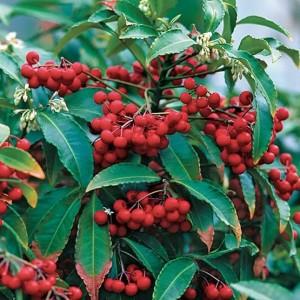Culture methods and matters needing attention of cinnabar root
Cinnabar root is a variety of purple Taurus, distributed in the middle and lower reaches of the Yangtze River of Chinese mainland, South China, Taiwan, Japan, Ryukyu and Java. How much do you know about living? Today, the editor will introduce the methods and matters needing attention of cinnabar root culture.


Cinnabar root is a shrub with a height of 1-2m. Except for lateral special flower branches, there are no branches. Leaves alternate, petiole about 1cm, leaf blade leathery or strongly papery, oval, elliptic-lanceolate to oblanceolate. Produced in the southeast of Xizang to Taiwan, Hubei to Hainan Island and other areas, 90-2400 meters above sea level in the sparse, dense forest shade wet bushes. India, Myanmar through the Malay Peninsula, Indonesia to Japan.


[humidity Management]
Cinnabar root likes the humid or semi-dry climate environment, which requires that the air relative temperature of the growing environment is 50-70%. When the air relative humidity is too low, the lower leaves yellowing and falling off, and the upper leaves are not glossy.
[temperature Management]
Because cinnabar root is native to the subtropics, the temperature in winter is very strict, and the growth stops when the ambient temperature is below 8 ℃.

[lighting management]
Cinnabar root has a strong adaptability to light. Put in indoor maintenance, as far as possible in places with bright light, such as well-lit living room, bedroom, study and other places. After indoor maintenance for a period of time, it is necessary to move it to an outdoor shaded place for maintenance for a period of time, so alternately.
[pruning]
When the plant enters the dormant or semi-dormant period in winter, the branches such as thin, disease and insect, withered and overdense should be cut off. The branches can also be arranged in combination with cuttings.

[fertilizer and water management]
Cinnabar root in addition to adding organic fertilizer on the basin, in the usual maintenance process, but also to carry out appropriate fertilizer and water management. Generally, a small groove is opened 30 cm to 100 cm away from the root neck (the larger the plant is, the farther away from the root neck). The width and depth of the groove are both 20 cm. The ditch is sprinkled with 25-50 jin organic fertilizer, or 1-5 two-grain compound fertilizer, and then watered. After the beginning of winter, before the beginning of spring, fertilize again according to the above method, but do not need watering.
How about the culture method of cinnabar root? After sowing in late autumn, early spring or winter, when you encounter a cold wave and low temperature, you can wrap the flowerpot with plastic film to keep warm and moisture. after the seedlings are unearthed, the film should be opened in time, and every morning, or in the afternoon let the seedlings receive the sun's light, otherwise the seedlings will grow very weakly, after most of the seeds come out, they need to plant properly: pull out the diseased and unhealthy seedlings. So that the left seedlings have a certain space between each other, when most of the seedlings grow out of 3 or more leaves, they can be transplanted.
Li Shizhen once described: "cinnabar roots grow deep in the mountains, the seedlings are about a foot high, the leaves are like holly, the back of the leaves are red, the summer is luxuriant, and the roots are as big as tendons and red, which is like a hundred taels of gold." It can be seen that the medicinal value of cinnabar root was reflected incisively and vividly in ancient China. That's all for today's introduction of cinnabar root culture methods and matters needing attention. Thank you for your appreciation.
-
Knowledge of flower cultivation
Wechat: yanghua29
Flower cultivation knowledge, ask and answer, solve the problem of flower cultivation!
- Prev

A complete collection of breeding techniques of colorful pheasants
Many of my hometown friends in the countryside must have eaten pheasant, which tastes like a word-incense! Pheasant, also known as pheasant, was first introduced to me from Nevada.
- Next

Culture methods and matters needing attention of Cymbidium
The cultivation technique of Cymbidium is to cultivate Cymbidium with water. You can't get tap water directly. You must use trapped water. The so-called "trapped" water means putting tap water in.
Related
- On the eggshell is a badge full of pride. British Poultry Egg Market and Consumer observation
- British study: 72% of Britons are willing to buy native eggs raised by insects
- Guidelines for friendly egg production revised the increase of space in chicken sheds can not be forced to change feathers and lay eggs.
- Risk of delay in customs clearance Australia suspends lobster exports to China
- Pig semen-the Vector of virus Transmission (4)
- Pig semen-the Vector of virus Transmission (3)
- Five common causes of difficult control of classical swine fever in clinic and their countermeasures
- Foot-and-mouth disease is the most effective way to prevent it!
- PED is the number one killer of piglets and has to be guarded against in autumn and winter.
- What is "yellow fat pig"? Have you ever heard the pig collector talk about "yellow fat pig"?

